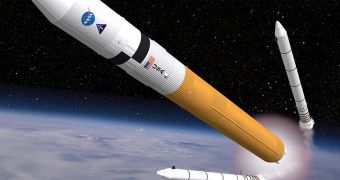NASA's ambitious Ares V program – a project that envisions the construction of a massive orbital two-stage delivery system capable of carrying approximately 396,000 pounds (180,000 kg) into orbit – is now scheduled to be used for far more than simply delivering Altair lunar landers above the Earth, as part of the Constellation project. Apart from being employed to fuel a future lunar base and potentially even for a trip to Mars, the massive system could also be used to deploy new, huge space telescopes to orbit.
"Imagine the kind of telescope a rocket like that could launch. It could revolutionize astronomy," advanced astronomy concepts leader Harley Thronson, from NASA's Goddard Space Flight Center in Greenbelt, Maryland, says. "The bigger the better. NASA's new Ares V rocket is going to completely change the rules of the game."
"The science community is taking a hard look at Ares V and its capability. It helps them enable a whole other class of mission," NASA's Altair lunar lander project manager Kathy Laurini adds in an interview for Space.
The Ares V rocket will be nearly 381 feet (116 meters) tall, and will be capable of lifting more than 180 metric tons of cargo to low Earth orbit. The potential range of applications for the two-stage system is amazing, and it includes delivering objects the size of 17 school buses put together hundreds of miles above the ground. International Space Station (ISS) modules could be built to more massive scales, and could house more equipment than they currently do.
Scientists say that, although missions designed to carry massive telescopes via the Ares V would cost in the vicinity of $5 billion each, the amount of data sent by a telescope with a lens three times larger than that of Hubble would be far more valuable. "The 8-meter-diameter telescope can only fit inside an Ares V payload fairing," a 2008 National Research Council report explains. Hubble's lens is currently 2.4 meters across, but a future telescope with an 8-meter lens could make the best telescope in the world today obsolete.
Some of the projects in store for Ares V, scheduled to be tested in 2018, include landing people on the Moon and Mars, and sending probes and orbiters to Neptune and its satellites, in time frames shorter than years. "We could get incredible astronomy from this big rocket. I can't wait," Thronson concludes.

 14 DAY TRIAL //
14 DAY TRIAL //